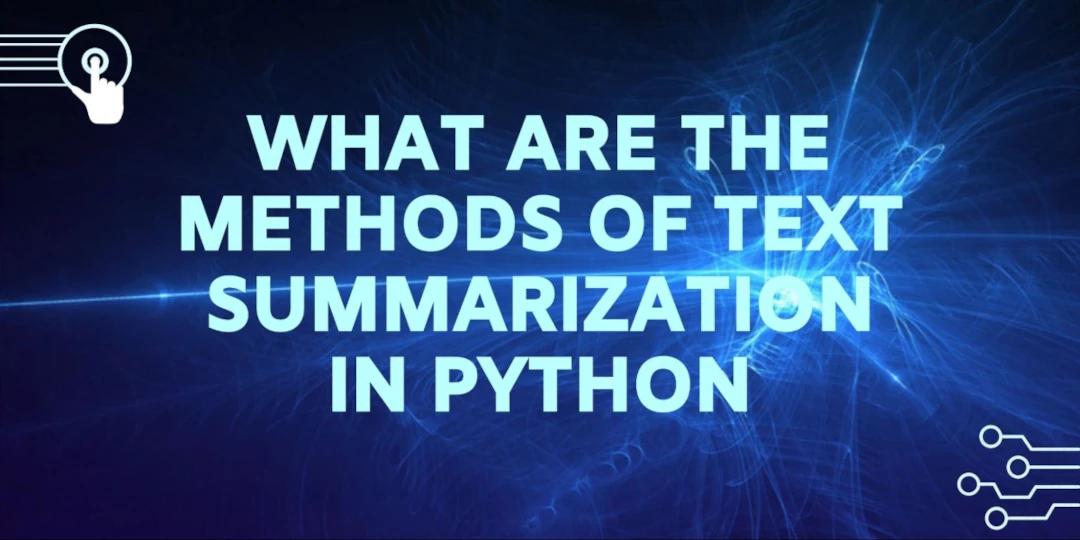Tue Feb 27 2024
WHAT ARE THE METHODS OF TEXT SUMMARIZATION IN PYTHON

Python is a popular object-oriented programming language that is useful for creating advanced websites, applications, and tools to automate tasks for humans. When it comes to text summarization, Python makes use of different methods.
In this article, I am going to discuss those methods in detail. But before that, let me quickly explain what text summarization actually is.
What Is Text Summarization?
It is a technique that refers to converting long pieces of text into short and concise ones to quickly understand their meaning or idea. The short version will contain only the original text's main points and deliver the same meaning.
Text summarization can be done in multiple ways. One is by manually reading the source text efficiently, and then summarizing it by using its main points. Although this will take a lot of time and effort, but also increases the chances of errors.
Another way is by utilizing a summarizer that will automatically create a short and concise summary of a given text by only using its main points.
Different Methods Of Text Summarization In Python
Python uses two different approaches to perform text summarization, those approaches are as follows:
- Abstractive summarization: In this approach, Python creates a summary that captures important ideas or points of the input text. The summarized text will contain new words and phrases that the input text does not contain.
- Extractive summarization: In extractive summarization, Python will create a summary by using the same words and phrases that the original text contains.
Now, let’s head towards the methods.
1. Genism
Genism is the very first method for performing text summarization with Python. It is an open-source Python library widely used for unsupervised topic modeling, retrieval of text based on similarity, and other NLP (Natural Language Processing) tasks. This library operates on advanced statistical machine learning.
The library utilizes a special algorithm known as “TextRank” to perform the summarization quickly and efficiently. TextRank is basically a graph-based ranking model for text processing and is highly useful for finding the most relevant sentences in a given text. This is the model that actually helps Python to efficiently perform summarization.
However, it follows two approaches that are listed below:
- Keyword extraction
- Sentence extraction
However, you will have to type specific code if you want to perform summarization with this method.

In the image above, I have provided multiple codes, one is for summarizing text based on percentage, and the other is according to the given word count.
2. Sumy
Sumy is another Python library that is specially designed for extracting summaries from both plain text and HTML pages. Sumy makes use of different methods to create a text summary. Some of those methods are discussed below:
LexRank
LexRank utilizes an unsupervised technique along with diverse Natural Language Processing (NLP) algorithms that further make use of stochastic graph-based methods to figure out the relative relevance of textual units.
You have to make use of the following code to perform summarization with Sumy LexRank.

Latent Semantic Analysis (LSA)
LSA is a Natural Language Processing method that utilizes term frequency with singular value decomposition to summarize the given text. Due to its quickness and accuracy, this method has become one of the widely used summarizing methods of Python.
If you also want to use this method, then you have to run the following code:

So, these are some of the methods used by Sumy Library to summarize the given text.
3. Natural Language Toolkit (NLTK)
This is another method of text summarization in Python. NLTK is basically an online platform used for building Python programs that will work with human language data for application in statistical natural processing.
NLTK contains several text-processing libraries for summarizing, tokenization, parsing, and many more. There is one major issue with this method, it requires a long code to set up the things to start the summarization process. Its code can be seen in the picture below:

4. Text-to-Text Transformer (T5)
This is the final method of text summarization in Python. T5 is a well-known Python transformer that uses a text-to-text approach to automate text-related tasks like summarization.
To make use of this method, you will have to first install PyTorch and Hugging Face’s Transformers. This can be done by writing the “pip install transformers” command. See the picture attached below for the full code.

So, these are some of the methods that are being used to perform text summarization in Python.
Wrapping Up
Python is a well-known object-oriented language that is being used to create tools and applications to automate different tasks. Text summarization is one of those tasks. In this article, I have explained the different methods that Python uses to summarize the given text. I hope you will find them useful.